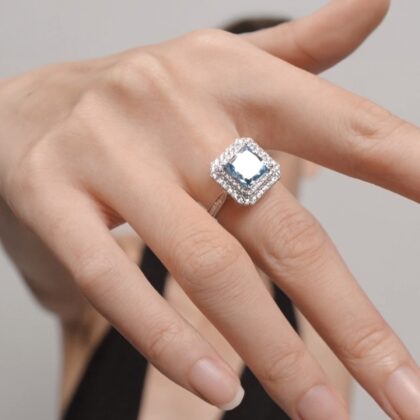Introduction to Lab-Grown Diamonds
In recent years, lab-grown diamonds have emerged as a compelling alternative to natural diamonds for engagement rings. These diamonds, cultivated in controlled laboratory environments, offer a sustainable and ethical choice without compromising on beauty or durability. As more couples prioritize sustainability and ethical sourcing, the popularity of lab-grown diamond engagement rings continues to rise.
Advantages of Lab-Grown Diamond Engagement Rings
One of the most significant advantages of choosing a lab-grown diamond engagement ring is its affordability compared to natural diamonds. These diamonds typically cost 30-40% less than mined diamonds of similar quality, making them accessible without stretching your budget. Moreover lab grown diamond engagement ring, lab-grown diamonds are produced with minimal environmental impact and ethical concerns, appealing to conscientious consumers.
Quality and Properties of Lab-Grown Diamonds
Lab-grown diamonds are created using advanced technological processes that replicate the natural diamond-growing environment. They share the same physical and chemical properties as natural diamonds, including hardness, brilliance, and fire. The clarity and color of lab-grown diamonds can vary, with options ranging from flawless to near-colorless grades.
Choosing a Lab-Grown Diamond Engagement Ring
When selecting a lab-grown diamond engagement ring, consider factors such as carat size, cut quality, and setting style. Many jewelers offer customization options, allowing you to create a unique ring that reflects your personal style and preferences. Whether you prefer a classic solitaire or a vintage-inspired halo design, there are numerous choices available to suit every taste.
Comparison with Natural Diamonds
While lab-grown diamonds offer affordability and ethical advantages, they are comparable to natural diamonds in terms of appearance and durability. Both types exhibit the brilliance and sparkle that diamonds are known for, making it challenging to distinguish between them without specialized equipment. The primary difference lies in their origin and cost, with natural diamonds being formed over millions of years underground.
Certifications and Guarantees
To ensure the authenticity and quality of your lab-grown diamond engagement ring, look for certifications from reputable laboratories such as the Gemological Institute of America (GIA) or the International Gemological Institute (IGI). These certifications provide assurance that your diamond meets industry standards and specifications. Additionally, many manufacturers offer guarantees on their lab-grown diamonds, covering aspects like craftsmanship and diamond performance.
Popular Styles and Designs
From classic round cuts to modern princess cuts, lab-grown diamond engagement rings are available in a wide range of styles and designs. Popular trends include minimalist settings, vintage-inspired details, and eco-friendly materials. Whether you prefer a sleek platinum band or a romantic rose gold setting, there are options to complement every aesthetic and lifestyle.
Caring for Lab-Grown Diamond Rings
Maintaining the beauty and brilliance of your lab-grown diamond engagement ring is simple with regular care and cleaning. Use a soft brush and mild detergent to remove dirt and oils from the diamond and setting. Avoid exposing your ring to harsh chemicals or abrasive materials that could damage its surface. With proper care, your lab-grown diamond ring will maintain its sparkle for years to come.
Customer Reviews and Experiences
Many couples who have chosen lab-grown diamond engagement rings express satisfaction with their decision. Positive reviews often highlight the affordability, ethical considerations, and quality of lab-grown diamonds compared to natural alternatives. Customer feedback can provide valuable insights into the buying experience and product satisfaction.
Buying Guide: Where to Purchase
When shopping for a lab-grown diamond engagement ring, consider purchasing from reputable retailers and manufacturers known for their commitment to quality and customer service. Online retailers offer convenience and a wide selection, while brick-and-mortar stores provide the opportunity to view rings in person. Compare pricing, return policies, and customer reviews before making a decision.
Lab grown diamonds, created through advanced technological processes, offer a brilliant alternative to their natural counterparts. These diamonds are synthesized using high-pressure, high-temperature (HPHT) or chemical vapor deposition (CVD) methods, replicating the conditions under which natural diamonds form.
Financial Considerations
In addition to their lower initial cost, lab-grown diamond engagement rings may offer financing options and payment plans to fit your budget. Explore options such as installment payments or credit programs offered by retailers. Remember to factor in maintenance costs and insurance coverage when budgeting for your ring.
The Future of Lab-Grown Diamonds
As technology continues to advance, the future looks bright for lab-grown diamonds. Innovations in diamond-growing techniques promise to enhance quality and reduce production costs, making lab-grown diamonds even more accessible to consumers. Market trends indicate a growing preference for sustainable and ethical jewelry choices, positioning lab-grown diamonds as a compelling option for future engagement rings.
Conclusion
Choosing a lab-grown diamond engagement ring offers a blend of affordability, ethical sourcing, and aesthetic appeal. Whether you’re drawn to their environmental benefits or attracted by their competitive pricing, lab-grown diamonds provide a modern and sustainable alternative to traditional mined diamonds. With a range of styles, designs, and customization options available, finding the perfect lab-grown diamond ring to celebrate your commitment has never been easier.



